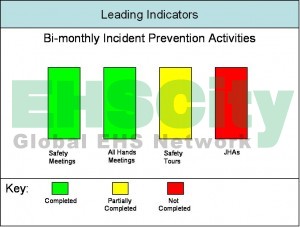Businesses use key performance indicators (KPIs) to measure progress toward specific health and safety goals or simply to monitor trends associated with corporate and facility activities or special projects. KPIs are used as a means to collect data and communicate trends, which can then be used to indicate where further improvements and resources are required.
KPIs that represent what has already happened are referred to as “lagging indicators.” Lagging indicators are commonly used in company communications to provide an overview of performance, such as the tracking of injury statistics, exposure incidents, and regulatory fines. “Leading indicators” are more predictive of future performance results. They are viewed as proactive measurements. These might include, among other things:
- Number of audits or inspections performed.
- Number and types of findings and observations.
- Timeframe required to close action items.
- Training completed.
- Near miss incidents.
- Timely preventive maintenance tasks performed.
- Safety committee meetings.
In either case, KPIs must be quantifiable and tied to specific targets.
Selecting KPIs
Which KPIs are best for a particular organization depends on several factors:
- Where is the organization today with respect to health and safety performance?
- Where does the organization want to be tomorrow?
- Who receives the KPI data and what do they do with it?
- How are KPIs and the conclusions that are drawn from the KPIs communicated to others?
To develop meaningful KPIs, health and safety managers first need to understand the safety risks of their operations, evaluate the systems that are in place to manage risk, and understand the company’s business plan and culture. From there health and safety managers can decide where they would like the organization to be in the short and long term. It’s great to be recognized as one of the industry leaders in the area of safety, but if the organization has a reactive or emerging culture, it might want to set a short-term goal of ensuring that it is in compliance with applicable legal requirements.
When communicating KPIs, it’s also important to understand who the audience will be. For example, establishing a goal of completing all incident investigations within 24 hours may help to improve overall safety performance, but it’s unlikely to gain favorable public attention. Environmental Resources Management (ERM) reviewed the most common publicly reported environmental, health and safety indicators among 44 major companies and found that the companies all reported lagging indicators. Does this mean that these companies are not interested in improving safety performance? No, but it may be an indication that the public doesn’t want to know what companies are doing to improve performance but is interested in knowing how companies perform.
Once the business and goals have been evaluated, KPIs can be selected. Keep the following points in mind when selecting KPIs:
- Quantity does not equal quality.
- Measure the most important things, not everything.
- Ensure field and line management buy-in.
- Consider piloting metrics before rolling them out company-wide.
- Don’t let the cost of measuring exceed the value of the results.
Managing KPIs
For KPIs to be successful, there needs to be a system for tracking, communicating, and improving performance. If data are collected but aren’t communicated to the appropriate audience, efforts will not be successful. In an effort to increase accountability at the plant level, one of ERM’s clients developed a monthly safety dashboard to highlight safety performance for leading and lagging indicators in a simple and highly visible manner. To date it has been highly successful for increasing accountability and awareness.
Finally, KPIs will evolve as the organization changes. Health and safety managers should be prepared to continuously evaluate their progress in tracking health and safety performance and the benefits of the KPIs. When necessary and appropriate, KPIs should be modified to reflect changing circumstances or drive further improvement.
About the Author
Jan Baldauf, P.E., is a senior project manager at Environmental Resources Management in Ewing, New Jersey, U.S.A. She has more than 23 years of practical experience in developing solutions and designing systems for complex health and safety projects. Ms. Baldauf serves as the health and safety practice lead for ERM’s MidAtlantic Region. In addition to her consulting experience, Ms. Baldauf developed and managed a comprehensive EHS program for a pharmaceutical development and manufacturing facility. She works with clients to develop cost-effective solutions to limit long-term liability and develop programs and metrics to improve safety awareness and behaviors.
4 Comments to “Measuring Safety Performance: What are KPIs?”
-
kealeboga mogaleemang says:
is it possible for an organisation to dismiss an employee for not following certain safety rules while the organisations is not yet up to the required safety standards and employees are not briefed on their roles and organisations culture on safety is negative due to emphasising on employee rules and less on management policies
-
Mike Bittner says:
Warren, this would be an excellent question and request to post on Linked In under one of the professional services groups that are devoted to environmntal, health and safety.
-
warren jacques says:
Not having worked with KPI’S before and not understanding much of them, how do i get infromation reguarding to Work Health & Safety KPI’S in the most simplest terms or Document Templates that might help me head in the right direction.
-
Saurabh Srivastava says:
Wonderful document and information on safety matrix.

